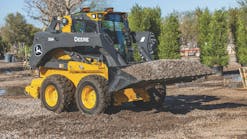Keep On Rollin': Tips for Extending the Life of Skid Steer Tires
Anyone in the construction industry knows the value of a skid steer. With the ability to perform many tasks, contractors depend on these machines to get jobs done. While the importance of maintaining the machine is seldom overlooked, what about the tires? They are an integral part of the skid steer’s operation and must be cared for.
To ensure the tires stay in it for the long haul, consider following a simple maintenance schedule. Because four different types of skid steer tires exist, maintenance requirements will be slightly different for each. The following tips and reminders will be helpful for all types of skid steer tires.
No Dirt Allowed
Because it’s easier to detect problems on clean equipment, the first rule of maintenance is to keep the tires clean. Simply hosing them down will clean off excess dirt and may allow an operator to spot a minor problem before it becomes serious. A few things to look for are bubbles and bumps, cracks, or objects stuck in the rubber.
Change It Up
Now that the tires are clean, it’s an ideal time to check for excessive or uneven tread wear. Often times with skid steer tires, the front two will wear faster than the rear two or vice versa. At the first sign of uneven wear, rotate the tires. Failing to do so will cause one pair of tires to wear out much faster than the other, reducing the service life of the entire set.
Four on the Floor
Speaking of uneven tire wear, it is possible to reduce and even prevent it, simply by being aware of how the skid steer is being operated. When an operator has a load in front of him, he typically will dig the bucket as far as possible under the load, resulting in the front two tires coming slightly off the ground. The front two tires end up doing nothing while the stress of the load is entirely on the back two tires, accelerating their wear. To avoid this, always be conscious of keeping all four tires on the ground when lifting and carrying loads.
Stay off the Road
Skid steer tires are meant to spend their lives in contact with the ground, so they are designed to withstand a variety of terrain. However, each will also have surfaces they are not intended for. Because of this, operators must be aware of where they are driving the skid steer. Driving on surfaces that are not meant for the tire, such as roads, can result in accelerated wear.
Take Care
Along with making a conscious effort to operate skid steers on proper surfaces, users need to pay extra attention to obstacles in their path. While this may seem obvious, consider the environments in which skid steers work. Recycling yards, warehouses and construction sites are often littered with debris. Foam-filled tires can be punctured and leak, pneumatics can go flat, and semi-pneumatics can be damaged if the skid steer operator is careless. While the tires are built to withstand a large amount of abuse, they aren’t indestructible.
Off the Rim
Every solid, foam-filled and semi-pneumatic tire has a retaining ring, which holds the tire on the rim. If an operator is being careless, it’s possible to snag the rim on an obstacle. This can result in the retaining ring popping off and being run over. While it isn’t expensive to replace the ring, the downtime that the skid steer experiences while the tire is being repaired can be costly.
Don’t Feel Pressured
For pneumatic tires, the biggest concern to be aware of is the tire’s air pressure. Because pneumatic tires are filled with air, monitoring and adjusting air pressure is the most important step to ensuring a long tire life. Tire pressure that is too great or too anemic will result in accelerated and uneven wear, and increase the likelihood of flats. Consult the owner’s manual for the ideal air pressure level, and check it daily, or weekly, depending on how often the skid steer is used.
Roll On
Skid steer tire maintenance isn’t difficult, nor does it take a lot of time. All it takes is commitment from the operator to stick to a basic maintenance schedule. Spending just a few minutes each day caring for the tires could have a positive impact on their longevity and the overall productivity on the jobsite.
George Zafirov is Marketing Manager for McLaren Industries.



